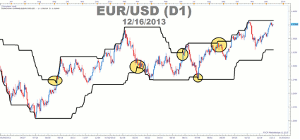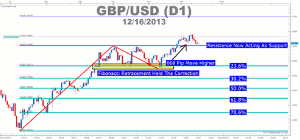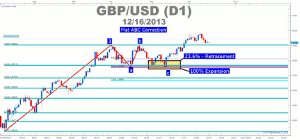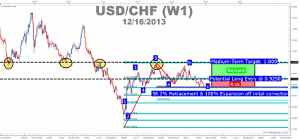While a Fibonacci confluence doesn’t guarantee a profitable trade, it does try and put the odds of your trading edge in your favor, says Tyler Yell of DailyFX.com.
At first glance, trading appears random. When you pull up a chart for the first time, it’s hard to imagine that there’s any order to the price action. However, over time, you begin to learn that some things like Elliott Wave, Fibonacci, or even simple tools like moving averages appear to bring a method to the madness so that you can build a trading plan.
Looking for Fibonacci Retracement & Expansions to Meet
Trend trades often take one of two approaches for entry. The easiest approach as claimed by Richard Donchian of the Donchian channels is buying breakouts in the direction of the trend. While a very good approach for low-leverage traders, entering on major breakouts doesn’t always play out as you’d wish.
Breakouts Don’t Always Follow Through

Presented by FXCM’s Marketscope Charts
Click
to Enlarge
A more difficult approach that is often favored by experienced traders is to enter on trend corrections. Entering on a trend correction requires a bit of a steady hand, along with a few key tools to help you align your entries with technical precision. A tool that traders who utilize Elliott Wave or who are just fans of Fibonacci will be to initially learn to use Fibonacci retracements.
Fibonacci Retracements Help You See Where a Correction May End

Presented by FXCM’s Marketscope Charts
Click
to Enlarge
On the GBP/USD chart above, you can see multiple levels of retracements. The general rule when looking for entrances off a retracement is that the stronger the prior trend, the less the underlying market will retrace the move. The stronger trends like we see in GBP/USD since July will usually only retrace 23.6% or 38.2%. The newer, less defined impulses, will often retrace a good deal more such as the 61.8% or 78.6% retracement.
The general rule is that when you see price action of the retracement begin to weaken around a Fibonacci retracement level, that can be a sign to enter back in the direction of the prior trend. As an example, if a currency traveled 100 pips higher in an uptrend, and then retraced 38 pips, but you saw a lack of thrust beyond the 38-pip retracement, that can be an opportunity to enter in the direction of the original trend at an attractive price.
The difficulty of this strategy typically develops when traders aren’t sure whether price action is weakening or not. This is when traders will look deeper into the correction by turning to Fibonacci expansions. The purpose of a Fibonacci expansion is to use key turning points of a prior move to see when either a correction or impulse may run out of gas as governed by a Fibonacci relationship. Naturally, when the Fibonacci expansion off of a corrective move meets a Fibonacci retracement of a prior impulse, you may be looking at a special set-up.
Fibonacci Confluence within Elliott Wave
Elliott Wave allows you to time entries into a trend by utilizing pattern recognition and Fibonacci relationships. Of course, timing an entry means recognizing correcting patterns that often play out and utilizing Fibonacci levels to confirm that likelihood that the correction is finished.
Fibonacci Confluence with GBP/USD

Presented by FXCM’s Marketscope Charts
Click
to Enlarge
A majority of correcting patterns are made out of three-waves and impulses are made of five-waves. The common Fibonacci expansion relationships for the three-wave or three-move correction is that the last leg will either be 61.8%, 100% , or 161.8% of the first corrective move. The bread and butter is when the last leg, known as the c-wave, hits 100% of the first leg, which is known as the a-wave. This development recently took place on the GBP/USD but that move already played out so it’s time to look for the next opportunity.
A Fibonacci Confluence Example with USD/CHF
We know now that Fibonacci confluence is when the retracement of a prior impulse and the expansion of a correction meet near each other. While this doesn’t guarantee a profitable trade, it does try and put the odds of your trading edge in your favor. As the taper nears and US data is beginning to tick up showing that QE has temporarily helped the US economy, a few US dollar long opportunities begin to emerge.
2014 Trade for USD/CHF Based on Fib Confluence

Presented by FXCM’s Marketscope Charts
Click
to Enlarge
USD/CHF has a confluence of the 38.2% Fib retracement at 0.8860, which is where are now based on the 8/2011 low and 7/2012 high. The current leg labeled “c” on the chart above is the 100% expansion when you connect the three points from the 7/2012 high, 1/2013 low, and 5/2013 lower high. The first confirmation of the move higher would be on a break of 0.9250. Based on a prior price action, a target for Q1 2014 could be around 1.0000.
By Tyler Yell, Trading Instructor, DailyFX.com





















